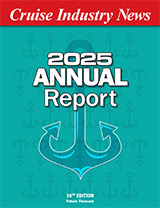The world cruise fleet is set to grow its annual passenger capacity 41 percent over the next six years to an estimated 15.3 million passengers by the end of 2006 from approximately 10.8 million passengers at the start of 2001. 2006 is the last year for which any newbuildings (options) have been ordered.
Broken down by source markets, in North America, the annual capacity is set to grow 43.7 percent over the same period, from approximately 7.5 million at the start of 2001 to 10.8 million at the end of 2006.
In Europe, the locally-based operators plan to grow their annual passenger capacity by 101.9 percent, from 1.7 million passengers to 3.5 million.
In Asia, meanwhile, the annual passenger capacity of Asian operators will decrease from approximately 1.6 million to 1.0 million based on announced ship deployments.
2001
Carnival Corporation dominates the industry with a 30.5 percent share of the worldwide market in terms of passenger capacity and 36.1 percent of the North American market.
Royal Caribbean Cruises (RCC) follows with 23.3 percent of the worldwide market and 32.4 percent of the North American market.
Star Cruises Group is third with a 12 percent share of the worldwide market and a 10.7 percent share of the North American market.
P&O Princess Cruises (POC) is fourth with a 9.7 percent share of the world market and a 7.8 percent share of the North American market.
Together, these four companies control 75.5 percent of the worldwide cruise market in terms of passenger capacity offered and 87.0 percent of the North American market.
2006
By 2006, Carnival will increase its worldwide market share to 33.4 percent and its North American market share to 39.6 percent, based on newbuilding orders and known ship deployments.
RCC, which will see strong capacity growth, will see its relative market shares, however, retrench to 21.9 percent on a worldwide basis and to 30.2 percent in North America.
POC is expected to boost its market shares to 12.6 percent worldwide and to 11.0 percent in North America.
Lacking newbuilding orders beyond 2002, Star will see its market shares reduced to 9.1 percent on a worldwide basis and to 7.0 percent in North America.
Thus, according to Cruise Industry News‘ estimates, the four companies will command 77.0 percent of the world cruise capacity and 87.8 percent of the North American cruise capacity in 2006.
Carnival
On a worldwide basis, Carnival will grow its total annual passenger capacity approximately 64.0 percent from an estimated 3.1 million at the start of 2001 to 5.1 million at the end of 2006.
By 2006, Carnival Cruise Lines will continue to be the company’s core brand with an annual passenger capacity of 2.7 million compared to an estimated 990,000 for Holland America Line (HAL) and 910,000 for Costa Crociere.
The three brands will account for nearly 90 percent of Carnival’s annual passenger capacity. But less than 20 percent of the company’s overall passenger capacity is expected to be filled from foreign markets, according to CIN projections. Together, Costa and Airtours are expected to generate about one million passengers per year by 2006.
In North America, Carnival is projected to grow its annual passenger capacity nearly 60 percent from 2. 7 million at the start of 2001 to 4.3 million by the end of 2006.
Carnival and HAL will account for 80 percent of the company’s annual North American passenger capacity.
RCC
RCC will grow its overall capacity by approximately 54 percent from just short of 2.2 million passengers at the start of 2001 to nearly 3.4 million by the end of 2006.
Since RCC is basically Royal Caribbean International and Celebrity Cruises, most of the growth will come in the North American market where RCC will boost its annual passenger capacity some 51 percent from 2001 to 2006.
The international component will be relatively modest – at 2.2 percent – unless RCC puts more ships into Island, its joint venture with First Choice. But that would in turn reduce the company’s North American market share.
Meanwhile, RCC is also experimenting with marketing Mediterranean cruises aboard the Splendour of the Seas exclusively to Europeans.
Star Group
As Star has started to cut back in the Far East, all of its growth is projected to come in North America at Norwegian Cruise Line (NCL) and Orient Lines.
On an international basis, Star will see a capacity reduction from 2000 to 2001 due to ship sales and repositionings.
Also in North America, NCL will see a reduction in capacity year-over-year despite the arrival of two new ships due to repositionings, longer cruises, and the withdrawal of the Norway.
In 2002, the Star Group will see a 3.3 percent capacity boost on an overall basis, while NCL and Orient Lines will see a combined capacity boost of 20.0 percent in the North American market.
But the group has no more ships on order beyond the 2002 deliveries.
POC
POC is set to grow its total worldwide passenger capacity 111 percent from year’s end 2000 to 2006, from an annual passenger capacity of 916,725 to 1,938,635.
In North America, POC is set to grow its capacity 52 percent over the six-year period, from an estimated 784,000 passengers by year’s end 2000 to 1.2 million by year’s end 2006.
North America will account for approximately 62 percent of all of POC’s passengers.
International
When all the numbers are added up, Carnival is also the largest international operator with Costa and Airtours’ Sun Cruises able to carry more than a million passengers in 2006; POC is second with an estimated annual capacity of 745,000 non-American passengers; Star is third with 641,000 and RCC is a distant fourth in an estimated capacity range from 100,000 to 150,000 shared by Island and the deployment of RCC’s own ships exclusively for European and South American passengers.
In Europe, Costa Crociere will be the largest cruise brand on the basis of an estimated annual passenger capacity of more than 900,000 by 2006, followed by P&O Cruises with 700,000, a combined Royal Olympic/Louis Cruise Lines at 660,000 (most of which are short-cruise passengers), Festival Cruises, including Spanish Cruise Line, with an estimated annual passenger capacity of 500,000, and Mediterranean Shipping Cruises at 250,000.
In the Far East, Star will continue to dominate a seemingly receding market with an estimated annual passenger capacity of 640,000.



